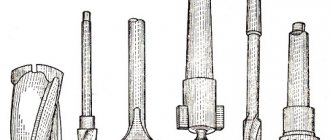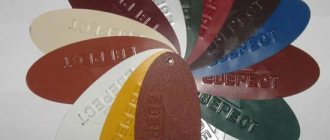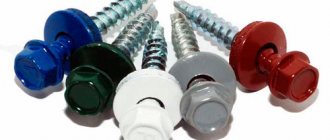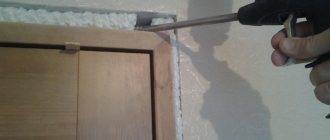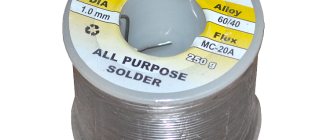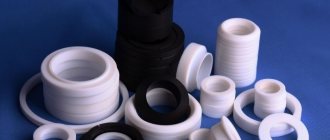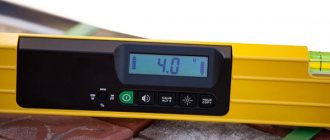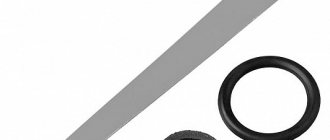Article reading time: 20 minutes
Author of the article:
Riveted connection of parts is widely used in construction, mechanical engineering, instrument making and many other industries. Rivets are a wide category of hardware that allows you to create strong and rigid permanent connections. The mounting units are designed for high durability under significant operating loads. Let's look at the main features, advantages and disadvantages of rivet joints.
Rivet connection - structural features
Riveted connections are permanent connections that are used to connect structural elements made of different materials. As a rule, they are used to fasten sheet metal parts. A rivet joint consists of two or more mating parts and a rivet, which creates the forces that hold the connecting members together. The rivet is inserted into coaxial mounting holes made in mating products by drilling or punching. The method of making holes is chosen depending on the material of the parts and their thickness.
The rivet consists of the following parts:
- round rod;
- embedded head, made during the manufacturing process of the fastener;
- closing head, which is formed during the riveting process.
This is a classic simple rivet design that has a wide range of applications. Also, a significant number of types of rivet fasteners have been developed for the installation of individual components. Today, special upsetting machines are used for the production of rivets. The rivet shank can be solid or have a through hole.
Riveting is done manually using a special tool, or using pneumatic riveting hammers and presses. Often, many rivets installed along a single axis are used to connect parts. This connection is called a rivet seam.
How to attach corrugated sheeting to a fence with self-tapping screws
You can attach the corrugated sheeting to the fence with your own hands, and all you need is a screwdriver. It is most convenient to do this with 4 hands, when there is an assistant. However, many people attach profiled sheets themselves, using simple devices that allow them to hold the sheet evenly.
Some, saving on self-tapping screws, end up with some of them being defective or with dull drills. This leads to excessive consumption of fastening material, or to double work - first you have to drill a hole with a thinner drill, and only then screw in the self-tapping screw.
Self-tapping screws are screwed through the sheet wave, tightly adjacent to the transverse beam. As a rule, self-tapping screws are installed through 2 waves. On average, one sheet of a standard two-meter fence (or one linear meter) will require 8-10 self-tapping screws. A free online calculator will help you calculate more accurately how many screws you need for your fence.
Material of manufacture
The stability, reliability, and strength of a riveted joint are determined to a large extent by the material of the rivet. It also determines the convenience and efficiency of installation and the need to use additional tools or equipment. In most cases, low-carbon steel grades, copper, aluminum, and some other types of non-ferrous metals and alloys are used to make rivets.
Taking into account the characteristics of rivet joints, the rivet material must meet the following basic requirements:
- a sufficient level of ductility for riveting;
- comparable coefficient of thermal expansion from the materials of the elements being connected - eliminates the occurrence of additional stresses that lead to wear and destruction of the connecting unit;
- homogeneous chemical composition of the materials of the parts being connected (steel-steel, aluminum-aluminum, copper-copper, etc.) - prevents the formation of galvanic currents, which lead to intense corrosion of metals.
Correct selection of rivet material, along with compliance with installation technology and selection of dimensional characteristics of fasteners, is an important condition for the durability and reliability of the connection.
The material directly affects the installation technology of riveted joints. Riveting using steel rivets with a diameter of no more than 10 mm, as well as fasteners made of copper, aluminum, brass, and other light alloys, is done using a cold method. Installation of connections from steel rivets with a diameter of over 10 mm is carried out using a hot method in order to achieve the required ductility of the metal.
Types of rivet connections
In industry and construction, many types of rivets and connections made with their help are used. The classification of rivet joints is provided according to the following main criteria:
- Functional purpose.
- Seam design.
- Number of slices.
- Number of rows of rivets.
- Mortgage head shape.
- Shape of the rod.
According to their functional significance, strong, dense and combined types of rivet joints are distinguished. Durable connections are designed to withstand operating loads. Dense - maintain the tightness of the connecting unit. Combination rivets and riveted joints combine these functions. According to the design of the connecting seam, joints with an overlap and a butt seam are distinguished. The first type is the most common. When installing an overlapping seam, special overlays are used.
Based on the number of cut lines that pass through the rivet shaft under the influence of operational loads, single-cut and multi-cut types of rivet joints are distinguished. For multi-slice types, the number of cut lines is not limited.
Based on the number of rivet rows, there are single-row, double-row, three-row, etc. connecting units. The total number of rows is not limited by regulatory requirements. Depending on the shape of the embedded heads, there are the following types of rivets and riveted joints:
- semicircular;
- cylindrical;
- semi-secret;
- secret, etc.
Another important criterion is the shape and design of the rivet shank. The rods can be:
- solid - traditional type of rod without a hole;
- hollow - a through hole is made in the body of the rivet rod;
- semi-hollow - the rod is divided into two halves, one of which has a hole in it, and the second is solid.
The main regulatory document regulating the types of riveted joints, methods of their implementation, as well as their dimensional characteristics, is GOST 10303-68. In addition, there are several other GOSTs that regulate this area.
Rivets against self-tapping screws
So, let's compare rivets and screws for fastening in terms of strength, installation speed, cost and appearance.
- Strength safety
Both rivets and mestizos adhere quite firmly to the metal. However, rivets that are too thin or low-quality screws can negatively affect the quality of the fastening. Drilling out screws and rivets will not be difficult. If you are worried about the safety of the fence, we recommend connecting each sheet in several places with bolts that are difficult to remove from the outside.
- Installation speed
Self-tapping screws significantly outperform rivets in terms of installation speed, since they do not require mandatory drilling of holes - the mestizos themselves serve as a drill. To install self-tapping screws, it is enough to have a drill or screwdriver with a suitable attachment, but to install rivets you need not only a drill, but also a riveter.
- Price
Today on the market you can find a lot of different offers at the price of screws and rivets. If you choose between one or the other, there is no significant difference in cost.
- Aesthetics
Roofing screws are larger and more noticeable, while rivets are less noticeable. However, if you match them to the color of the fence and install them in a straight line with equal distances from each other, they look quite aesthetically pleasing and even decorate the fence.
Where are riveted joints used?
The use of rivets for a long time remained the most common method of installing permanent connections before the development of welding technologies reached a sufficiently high level. However, even now the use of rivet joints is widespread in many industries. As a rule, they are used to connect structural parts made of sheet materials - steel, non-ferrous metals, plastic, etc. Large diameter rivets are used to connect elements of profiled metal - channels, I-beams, angles and others.
Rivets create strong connecting units with increased resistance to vibration loads. Therefore, the main areas where rivet connections are mainly used are those areas in which critical structures are regularly exposed to vibration and repeated loads. They are also used in the automotive industry, aircraft manufacturing, shipbuilding, instrument making and other industries.
In addition, in mechanical engineering and construction, rivet joints are used in cases where welding cannot be used:
- the materials of the parts to be connected cannot be welded to each other;
- when welding there is a danger of surface warping;
- the use of welding can lead to the tempering of parts that have undergone heat treatment;
- the use of welding is difficult for structural reasons or due to special conditions for performing installation work.
There are a large number of varieties of riveted joints that have become widespread in certain industries when installing various structures.
Choosing self-tapping screws for corrugated sheeting - what you need to pay attention to
For fences made of corrugated sheets, installers most often use roofing screws with a diameter of 5.15 and a length of 19 mm.
When choosing roofing screws, pay attention to the coloring. If the paint can be easily peeled off with a fingernail, then the self-tapping screw is susceptible to corrosion, which will be transferred to the fence sheet at the attachment point and ruin it.
High-quality mestizos are more durable, their drill diameter is smaller than the thread of a self-tapping screw, which means the adhesion to lags made of metal or wood will be stronger.
Any roofing screw has a special rubber material under its head. If the rubber is not of high quality, it will very soon be destroyed under the influence of the sun, wind and temperature changes.
Advantages and disadvantages of rivet fastening
Like any type of fastening elements, rivets have their advantages, thanks to which the scope of rivet joints remains quite wide, and disadvantages that limit their use. Let's look at their main advantages and disadvantages.
Advantages of rivet joints
Among the main advantages of riveted joints are the following:
- simplicity of technological execution of connecting units - no highly qualified personnel performing installation work are required;
- the ability to install complex assemblies - rivets allow you to connect two or more parts from different structural materials;
- the ability to connect non-weldable and dissimilar materials;
- no thermal effect on the materials of the parts being connected during installation - the technology allows you to connect elements for which the use of welding is unacceptable;
- high level of reliability, long service life of the assembly unit;
- increased resistance to vibration and repeated loads - the ability to install critical structures operated in difficult conditions.
Thanks to these advantages, rivet connections remain a relevant method of erecting structures, despite the available alternative technologies.
Disadvantages of riveted joints
At the same time, there are characteristic disadvantages of riveted joints, as a result of which their use is significantly reduced.
Main disadvantages:
- increased material consumption - rivets require increased metal consumption, which increases installation costs;
- increased labor intensity of installation work due to the need to complete the connection assembly;
- the need to use a special riveting tool;
- the need for a hot installation method for large diameter steel rivets;
- weakening of the structure and creation of additional stresses with a large number of holes for rivets;
- deformation of the rivet joint and rapid destruction if the hole diameter is incorrect.
Due to these disadvantages, rivet connections are rarely used if it is possible to install the structure using welding or threaded fasteners.
How to attach rivets to corrugated sheets
Before fixing the corrugated sheet with rivets, the corrugated sheet and joist are drilled in the place where the rivet will be located. Next, using a special spring tool - a riveter, the rivet is pressed against the profile sheet and, by flattening the metal, fastens the metal parts together.
On the one hand, the procedure is not complicated and does not require special skills; on the other hand, installing rivets requires first drilling a hole, which slows down the installation process.
